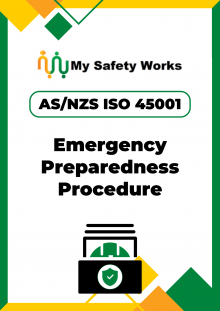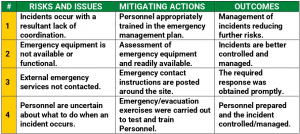
This emergency response procedure can assist your business comply with AS/NZS ISO 45001 2018, Occupational Health and Safety Management Systems clause 8.2, Emergency Preparedness and Response.
Emergency preparedness procedures are the plans and actions that are taken in advance to deal with an identified emergency. They are designed to protect people and property and minimize the effects of an emergency on the environment. Many different types of emergencies can occur, ranging from natural disasters to minor accidents and bomb threats. As such, emergency preparedness procedures must be tailored to the specific type of emergency that is likely to occur.
Emergency preparedness procedures are very important because they can help save lives and minimize damage in the event of an emergency. By having an emergency response plan or procedure to follow and knowing what to do in an emergency, people can be better prepared to respond quickly and effectively.
It is also important for a business to have clear and concise emergency procedures in place and to ensure that all employees are familiar with them. There are generally six main components to an emergency preparedness procedure, including:

1. Evacuation planning.
2. Emergency exercises and drills.
3. Emergency equipment and resources.
4. Controlling an emergency.
5. First aid and medical assistance.
6. Business recovery.
Upon activation of an emergency or the sounding of an emergency alarm, all persons at a workplace should assemble in a designated assembly area and await further instructions from the emergency controller(s). From there a move to a safer area can be coordinated if deemed necessary. All persons at a workplace should receive instructions about how to safely evacuate. Evacuation instructions should include all information about:
Note: All designated assembly areas should be sign-posted.
Emergency exercises and drills are activities that are done to prepare for an emergency. They help people to be ready for anything that might happen and to know what to do in different potential emergency situations. There are many different types of emergency exercises and drills, and it is important to choose the ones that are right for your situation. Some of the most common emergency exercises and drills include natural disasters, medical emergencies, earthquakes, storms and fire drills. It may also be important to have a plan for what to do if there is a power outage too.
Note: Any completed emergency exercise documents should be retained as documented information.
In the event of an emergency, it is critical to have the right equipment and resources on hand to ensure everyone’s health and safety. At a minimum, all buildings and machinery should be fitted with appropriate fire-fighting equipment in the form of extinguishers, hose reels and/or fire blankets. Medical equipment and trained first aid personnel should also be available for any potential medical emergency. Consultation and the participation of workers should always be undertaken to learn what equipment and resources may be needed.
If you find yourself in an emergency, it is important to stay calm and think clearly. There are a few key steps you can take to help control the situation and stay safe. Effective communication is a key factor in managing any emergency. To ensure effective communication of relevant information, all persons must try to remain calm and pass on facts (either verbally or by cell phone) that can be used to determine the level of response required for the emergency. It is also important that a trained and competent person take control of the situation and delegate the required tasks and actions needed.
Every workplace must determine the number of first aid or medical attendants they require to ensure adequate coverage to manage likely injuries and ill health. This should be done considering the size of the workplace and the number of personnel and:
Note: First aid or medical training must be provided by an appropriately authorized training provider and the courses must be certified.
Business recovery is the process by which an affected organization regains normal operations following an emergency. Aspects that may need to be considered and prioritized include:
Note: During the recovery process, the focus should be on returning all systems to normal status or reconstituting these systems to a new condition that is less vulnerable.
This 13-page emergency preparedness procedure can help you establish implement and maintain a process for the provision, maintenance and revising the planned response capabilities, including (but, not limited to):
The procedure prescribes the resources that may be needed and actions to follow to minimize the negative impacts on people, assets and the environment in the event of an emergency.
